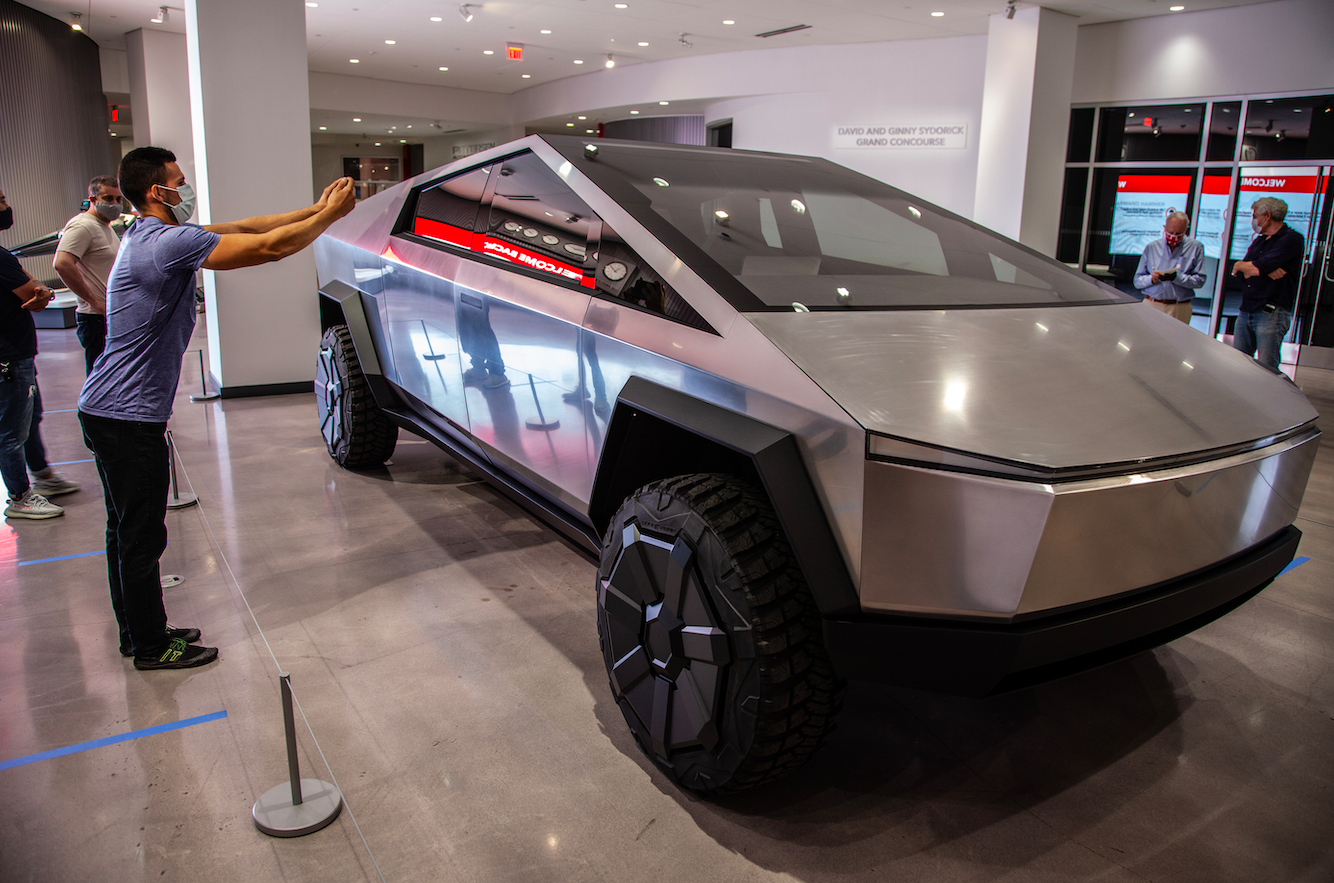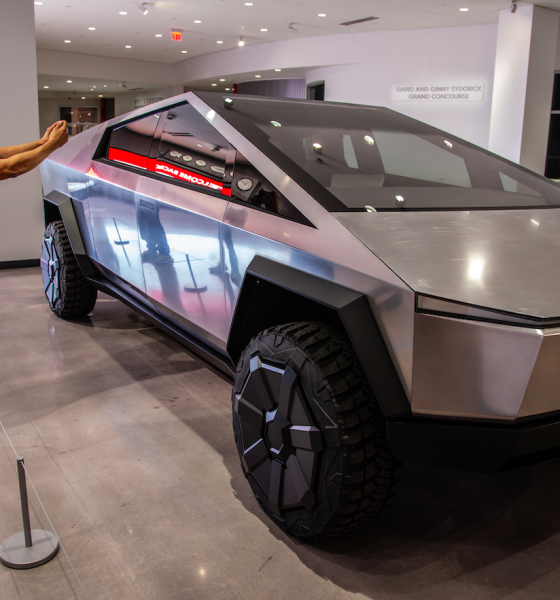Elon Musk has noted that Tesla is making “minor tweaks” to the Cybertruck’s new design to make it “better” in a recent tweet. Musk may have tweeted about the “minor tweaks” Tesla’s chief designer Franz von Holzhausen and his team made to the Cybertruck’s design earlier this year.
Musk recently responded to an inquiry to EV enthusiast @LouisFerreira, who asked why there needed to be a change to the Cybertruck at all. “Even the small details matter,” the Tesla CEO explained. In another recent tweet, Musk said that Tesla could release pictures of the refined Cybertruck with its changes in about “a month or so.”
During the TSLA Q3 earnings call, Musk further explained why improvements to the Cybertruck’s design needed to be made. “Generally, at Tesla, we really aim to make the car that is delivered better than the car that is unveiled. Because it always drives me crazy, car companies would unveil these awesome looking cars, like, great, you can’t wait until they make that,” he said.
“And then the car they actual[ly] make is like much worse, and—but it’s just—it’s like really disappointing? So man, we always want to make the car that we deliver be better than the car we unveil. And that’s the goal with the Cybertruck. So there’s like a lot of small improvements compared to what was unveiled. I think it’s going to be better than what we showed.”
Back in April, Musk hinted that Tesla was thinking of reducing the size of the Cybertruck by about 3%. Ultimately, Musk and Tesla’s design team decided against making it smaller. There are differing opinions about reducing the Cybertruck’s size amongst the Tesla community. Some love its massive size and daunting stance. Others preferred a slightly smaller Cybertruck, at least one that will fit in their garages.
It seems like Musk and Tesla have decided to release the Cybertruck in the original size it was unveiled for now. Musk hinted that Tesla might release a smaller version of the EV pickup in the future. The release of a smaller Cybertruck might heavily rely on the success of Tesla’s first release of the EV pickup.
Besides its size, Musk has previously remarked that the Cybertruck’s center line will be more leveled and its window sill height will be lowered in its production version. The all-electric car manufacturer was also working on increasing the EV pickup’s dynamic air suspension travel for a better off-roading experience. Musk has spoken of suspension improvements so the Cybertruck would “kick butt” at Baja as well.
The Tesla community has suggested some changes to the Cybertruck that may have made it to the EV pickup’s final design. For instance, the Tesla Truck Club group suggested that Tesla should consider releasing a feature that would allow drivers to roll down the rear window that separates the Cybertruck’s cabin from its bed. He said that such a function would make the EV pickup perfect for camping, especially when the Tonneau was closed, or for carrying longer items. Musk responded that the suggestion was “worth considering.”
Based on Musk’s tweets and statements about the Cybertruck during the recent earnings call, there are likely more changes to the EV pickup truck’s design than the ones mentioned previously. Although it may be safe to say that the Cybertruck’s unique triangular, origami-like exterior will most certainly stay the same.

News
Waymo sues Santa Monica over order to halt overnight charging sessions
In its complaint, Waymo argued that its self-driving cars’ operations do not constitute a public nuisance, and compliance with the city’s order would cause the company irreparable harm.

Waymo has filed a lawsuit against the City of Santa Monica in Los Angeles County Superior Court, seeking to block an order that requires the company to cease overnight charging at two facilities.
In its complaint, Waymo argued that its self-driving cars’ operations do not constitute a public nuisance, and compliance with the city’s order would cause the company irreparable harm.
Nuisance claims
As noted in a report from the Los Angeles Times, Waymo’s two charging sites at Euclid Street and Broadway have operated for about a year, supporting the company’s growing fleet with round-the-clock activity. Unfortunately, this has also resulted in residents in the area reportedly being unable to sleep due to incessant beeping from self-driving taxis that are moving in and out of the charging stations around the clock.
Frustrated residents have protested against the Waymos by blocking the vehicles’ paths, placing cones, and “stacking” cars to create backups. This has also resulted in multiple calls to the police.
Last month, the city issued an order to Waymo and its charging partner, Voltera, to cease overnight operations at the charging locations, stating that the self-driving vehicles’ activities at night were a public nuisance. A December 15 meeting yielded no agreement on mitigations like software rerouting. Waymo proposed changes, but the city reportedly insisted that nothing would satisfy the irate residents.
“We are disappointed that the City has chosen an adversarial path over a collaborative one. The City’s position has been to insist that no actions taken or proposed by Waymo would satisfy the complaining neighbors and therefore must be deemed insufficient,” a Waymo spokesperson stated.
Waymo pushes back
In its legal complaint, Waymo stated that its “activities at the Broadway Facilities do not constitute a public nuisance.” The company also noted that it “faces imminent and irreparable harm to its operations, employees, and customers” from the city’s order. The suit also stated that the city was fully aware that the Voltera charging sites would be operating around the clock to support Waymo’s self-driving taxis.
The company highlighted over one million trips in Santa Monica since launch, with more than 50,000 rides starting or ending there in November alone. Waymo also criticized the city for adopting a contentious strategy against businesses.
“The City of Santa Monica’s recent actions are inconsistent with its stated goal of attracting investment. At a time when the City faces a serious fiscal crisis, officials are choosing to obstruct properly permitted investment rather than fostering a ‘ready for business’ environment,” Waymo stated.
News
Tesla FSD v14.2.2 is getting rave reviews from drivers
So far, early testers have reported buttery-smooth drives with confident performance, even at night or on twisty roads.

Tesla Full Self-Driving (Supervised) v14.2.2 is receiving positive reviews from owners, with several drivers praising the build’s lack of hesitation during lane changes and its smoother decision-making, among others.
The update, which started rolling out on Monday, also adds features like dynamic arrival pin adjustment. So far, early testers have reported buttery-smooth drives with confident performance, even at night or on twisty roads.
Owners highlight major improvements
Longtime Tesla owner and FSD user @BLKMDL3 shared a detailed 10-hour impression of FSD v14.2.2, noting that the system exhibited “zero lane change hesitation” and “extremely refined” lane choices. He praised Mad Max mode’s performance, stellar parking in locations including ticket dispensers, and impressive canyon runs even in dark conditions.
Fellow FSD user Dan Burkland reported an hour of FSD v14.2.2’s nighttime driving with “zero hesitations” and “buttery smooth” confidence reminiscent of Robotaxi rides in areas such as Austin, Texas. Veteran FSD user Whole Mars Catalog also demonstrated voice navigation via Grok, while Tesla owner Devin Olsen completed a nearly two-hour drive with FSD v14.2.2 in heavy traffic and rain with strong performance.
Closer to unsupervised
FSD has been receiving rave reviews, even from Tesla’s competitors. Xpeng CEO He Xiaopeng, for one, offered fresh praise for FSD v14.2 after visiting Silicon Valley. Following extended test drives of Tesla vehicles running the latest FSD software, He stated that the system has made major strides, reinforcing his view that Tesla’s approach to autonomy is indeed the proper path towards autonomy.
According to He, Tesla’s FSD has evolved from a smooth Level 2 advanced driver assistance system into what he described as a “near-Level 4” experience in terms of capabilities. While acknowledging that areas of improvement are still present, the Xpeng CEO stated that FSD’s current iteration significantly surpasses last year’s capabilities. He also reiterated his belief that Tesla’s strategy of using the same autonomous software and hardware architecture across private vehicles and robotaxis is the right long-term approach, as it would allow users to bypass intermediate autonomy stages and move closer to Level 4 functionality.
News
Elon Musk’s Grok AI to be used in U.S. War Department’s bespoke AI platform
The partnership aims to provide advanced capabilities to 3 million military and civilian personnel.

The U.S. Department of War announced Monday an agreement with Elon Musk’s xAI to embed the company’s frontier artificial intelligence systems, powered by the Grok family of models, into the department’s bespoke AI platform GenAI.mil.
The partnership aims to provide advanced capabilities to 3 million military and civilian personnel, with initial deployment targeted for early 2026 at Impact Level 5 (IL5) for secure handling of Controlled Unclassified Information.
xAI Integration
As noted by the War Department’s press release, GenAI.mil, its bespoke AI platform, will gain xAI for the Government’s suite of tools, which enable real-time global insights from the X platform for “decisive information advantage.” The rollout builds on xAI’s July launch of products for U.S. government customers, including federal, state, local, and national security use cases.
“Targeted for initial deployment in early 2026, this integration will allow all military and civilian personnel to use xAI’s capabilities at Impact Level 5 (IL5), enabling the secure handling of Controlled Unclassified Information (CUI) in daily workflows. Users will also gain access to real‑time global insights from the X platform, providing War Department personnel with a decisive information advantage,” the Department of War wrote in a press release.
Strategic advantages
The deal marks another step in the Department of War’s efforts to use cutting-edge AI in its operations. xAI, for its part, highlighted that its tools can support administrative tasks at the federal, state and local levels, as well as “critical mission use cases” at the front line of military operations.
“The War Department will continue scaling an AI ecosystem built for speed, security, and decision superiority. Newly IL5-certified capabilities will empower every aspect of the Department’s workforce, turning AI into a daily operational asset. This announcement marks another milestone in America’s AI revolution, and the War Department is driving that momentum forward,” the War Department noted.










